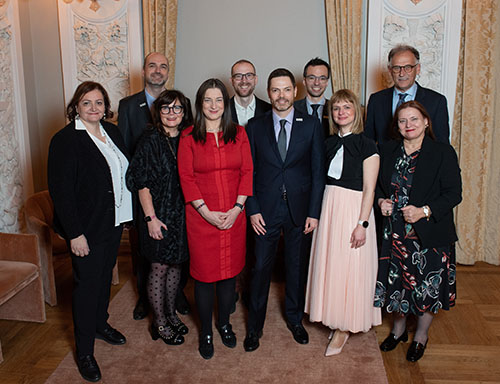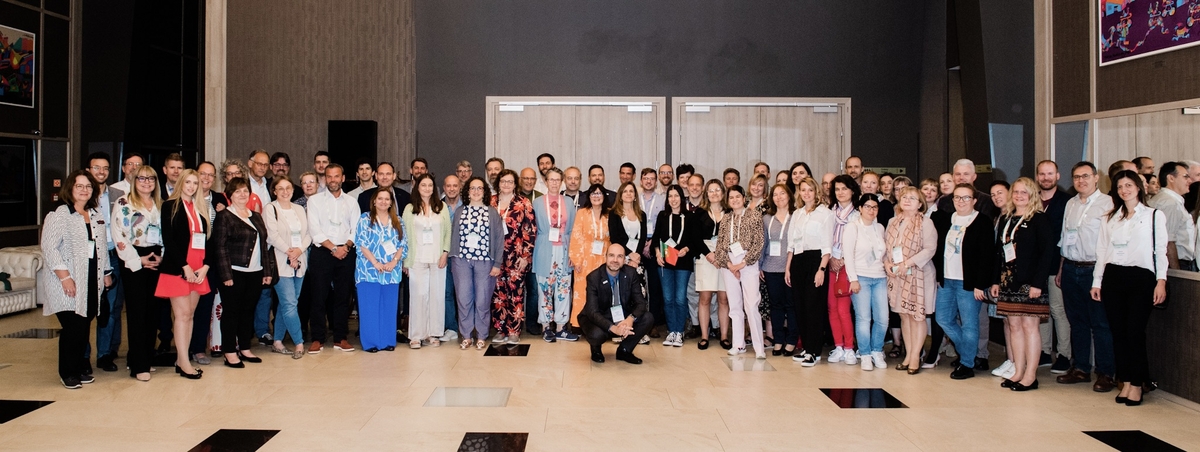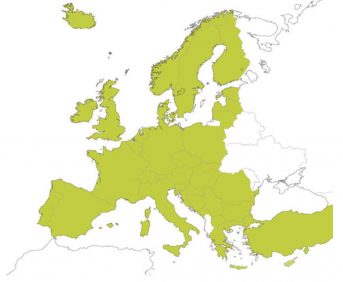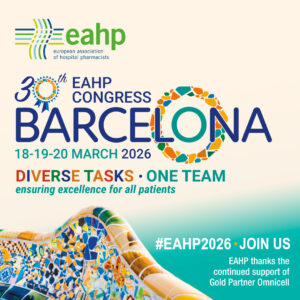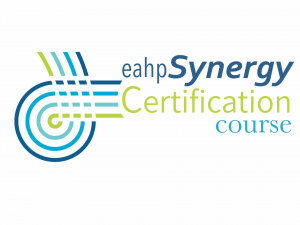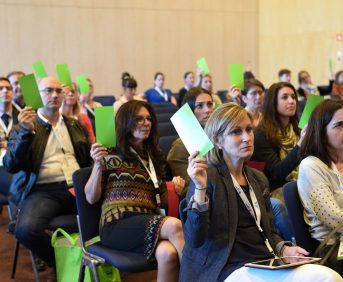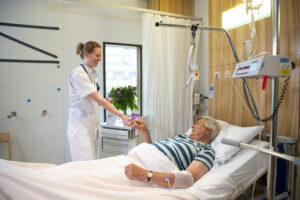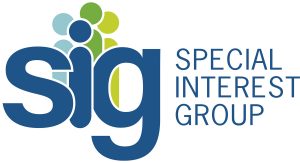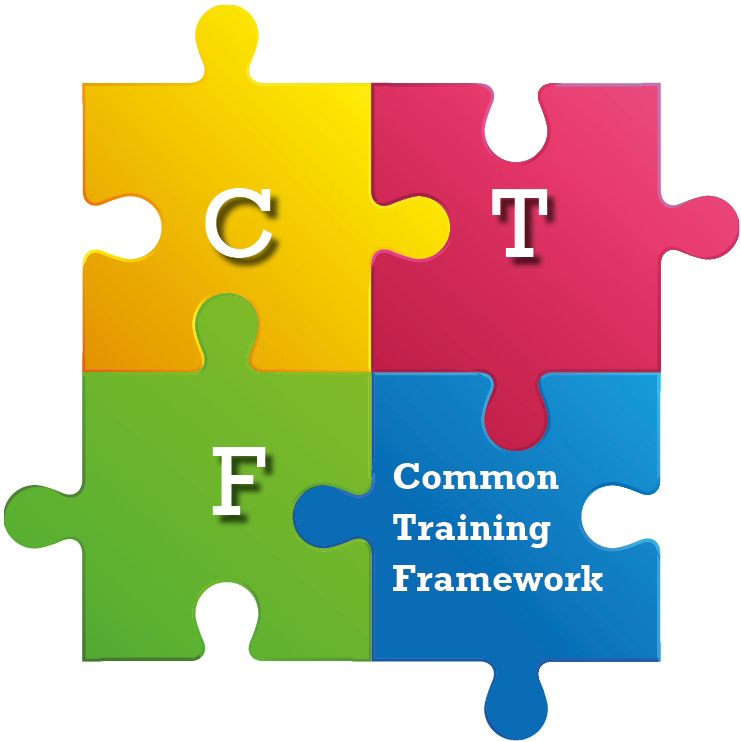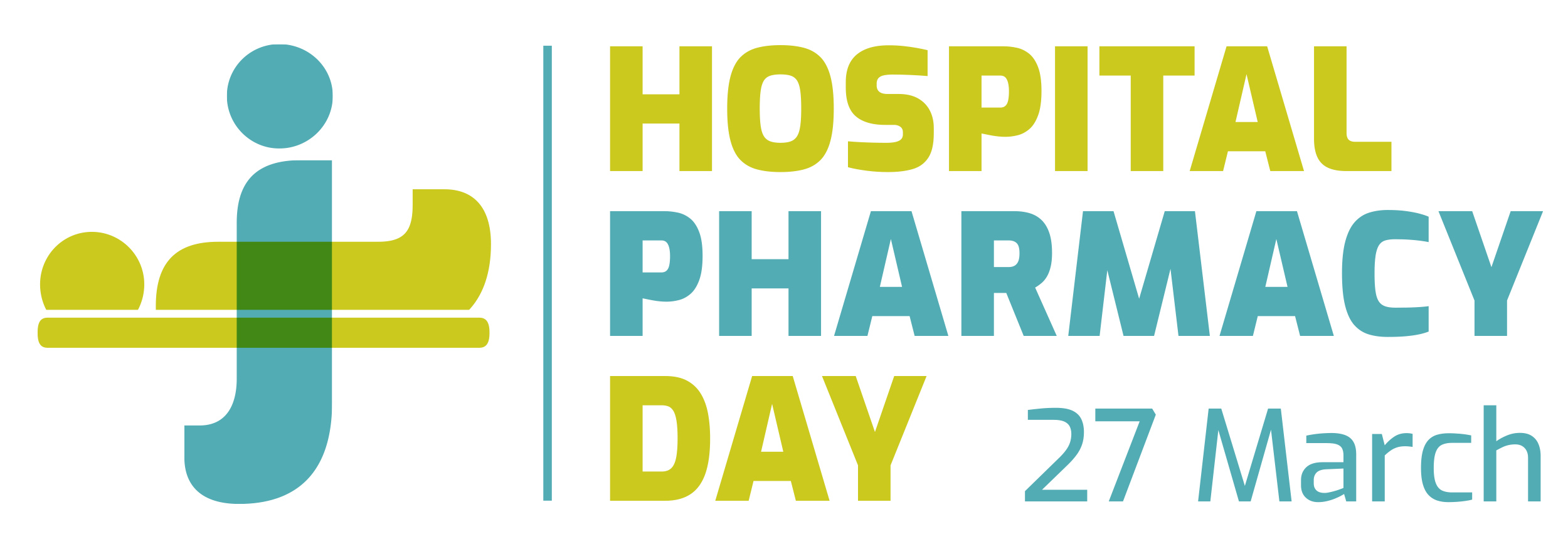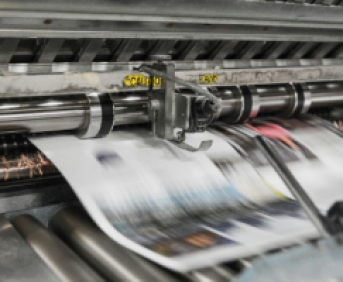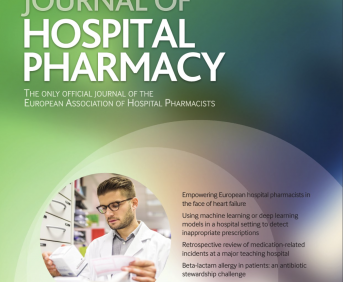MEDICATION MANAGEMENT OF COMBINATION THERAPY IVACAFTOR , TEZACAFTOR AND ELEXACAFTOR FOR CYSTIC FIBROSIS PATIENTS WITH THE F508del MUTATION BY THE HOSPITAL PHARMACY IN A CENTRAL GENERAL HOSPITAL
Pdf

European Statement
Clinical Pharmacy Services
Author(s)
DESPOINA MAKRIDAKI, KALLIOPI ALLAGIANNI, NIKOLAOS SKORDAS
Why was it done?
In our hospital is located the main CF Unit for Adults in the country. Ensuring that as many as possible young patients benefit from accessing the new and crucial treatment, even during COVID-19 period, reflects our commitment to improve patients’ outcomes and overall survival,
What was done?
A Phase 3, open-label clinical trial (CT) with 3 enrolled patients runs since April 2019 and two early access (EA) programs with 23 enrolled patients run since the end of July 2020 to permit the access of cystic fibrosis (CF) patients with the F508del mutation in the innovative combination therapy of ivacaftor, tezacaftor and elexacaftor (IVA/TEZA/ELEXA) in our hospital.
How was it done?
3 outpatients enrolled in the CT and procedures regarding the protocol have been followed strictly. Medication dispensing is conducted every 12 weeks.
In the EA procedure, 2 parallel programs have been approved by authorities, one for the homozygous including 19 patients and one for the heterozygous including 4 patients. Dispensing is programmed every 4 weeks, although an initial stock for 3 months was shipped to pharmacy.
The role of HPs was decisive for the quick start of the EA programs during COVID-19 period. Roadmap was designed at the beginning by HPs in collaboration with the physicians to accelerate approval and shipment procedures and also regarding licensing for each patient, drug receipt, storage, dispensing, accountability, electronic registry in designated EA platform and additional electronic recording and follow up in the electronic Pharmacy platform for both the IVA/TEZA/ELEXA and supporting therapies (e.g. inhaled antibiotics, a-dornase)
For 17 EA patients with chronic obstructive pulmonary disease in exacerbation, hospitalization before starting the IVA/TEZA/ELEXA therapy was necessary. HPs monitored closely their cartexes to avoid adverse reactions and delays in therapy.
HPs served all outpatients on personal afternoon appointments, to avoid overcrowding in the hospital during the pandemic.
What has been achieved?
Critically ill patients have been able to receive in priority the IVA/TEZA/ELEXA treatment, without cost, and valuable scientific experience has been gained.
What next?
EA programs have received 3 months extension until reimbursement negotiations are completed by authorities. In the meantime, we design a cost affordable procedure to ensure continuity of access for our patients.
Integration of clinical trials management into a safe and fully-automated onco-haematology workflow
Pdf

European Statement
Production and Compounding
Author(s)
FRANCESCA VAGNONI, ANDREA MARINOZZI, SABRINA GUGLIELMI, CHIARA CAPONE, FRANCESCA MURA, ADRIANA POMPILIO, SIMONE LEONI
Why was it done?
The management of CT requires thorough documentary evidence and well-organized reporting system in compliance with the Good Clinical Practice. Since 2009, the entire onco-haematology workflow is fully-controlled by information technology devices and robotic systems to prevent medication errors and guarantee data integrity. The implementation of APOTECAtrial was aimed to extend the same level of control to CTs.
What was done?
In 2018, a clinical trial (CT) managing system (APOTECAtrial) was integrated into the existing fully-automated workflow of the chemotherapy production unit. APOTECAtrial was developed to enable real-time visualization of CT-related data and trace the processing of investigational (IMP) and non-investigational (NIMP) medical products, such as delivery, assignment, preparation, return, and disposal.
How was it done?
A team of hospital pharmacists, physicians, clinical data managers, and IT specialists analysed the CT workflow and defined the system specifications. Data related to IMP/NIMPs (both for parenteral and oral administration), patients enrolled, and investigator/sponsor affiliations were entered into APOTECAtrial and sorted by CT. The onco-haematology unit’s electronic prescribing system was bidirectionally interfaced with APOTECAtrial. Aseptic preparation of patient-specific injectable therapies was implemented in the supporting device for manual preparation that checks dosage accuracy and identity by photographic and barcode recognition.
What has been achieved?
Since 2018, the overall number of CTs managed was 95. In total, 81 IMPs/NIMPs and 135 patients were entered into the system, while 2740 injectable therapies were prepared, 690 oral medications and 60 pre-filled syringes delivered. The following major objectives were achieved: automated inventory accounting and stock management, reduced manual time-consuming activities (i.e. documentation, transcription), standardized reports in digital not-editable format, and full traceability. In addition, audit trail tool tracks all user edits and changes performed at any stages of the CT management by electronically recording user’s name, date, and time. APOTECAtrial was evaluated by clinical research associates (CRA), clinical research organizations (CRO) and CT sponsors and approved for use in the daily clinical practice.
What next?
The project represents a good example of multidisciplinary collaboration focused on improving the quality of the processes in healthcare settings. The implementation of information technology and automation ensures improved data integrity, safety, and working efficiency, which are key determinants for managing CTs in hospital pharmacies.
Using in-house rapid quality control equipment to reveal morphine ampoule tampering – A case report
Pdf

European Statement
Patient Safety and Quality Assurance
Author(s)
Robert Baghdarsarian, Karin Hellström, Mattias Paulsson
Why was it done?
The health care providers at the Paediatric Emergency Ward discovered that when opening glass ampoules of morphine by snapping the top off, this did not result in the normal straight cut by the score. A close examination also revealed residual glue and the glass at the ampoule neck not being fully transparent. The sealed outer packaging also seemed manipulated for most of the morphine ampoules stored in the ward medication room. Simultaneously, staff discovered that one of the paediatric patients had not received the anticipated analgesic effect of the ordered morphine infusion.
What was done?
This case report describes how the compounding unit of Uppsala University Hospital (CU) was able to assist in analysing the contents of morphine glass ampoules and infusion solutions, in a case with suspected tampered containers
How was it done?
CU has invested in an easy-to-use spectrophotometer to check the concentration and identity of chemotherapy prepared in the clean rooms. The primary focus is to have an independent system to check preparations done by the chemotherapy robot e.g. in connection with software upgrades. This equipment was within hours adapted to be used for morphine analyses. The results clearly show that the infusion labelled 10 mg/mL was tampered with, containing only 0,4 mg/mL morphine. Samples were also sent to the Microbiological laboratory to check for risks for microbial exposure during infusion of tampered morphine.
What has been achieved?
CU was able to provide results of the contents of all ampoules, and the infusion solution administered to the patient, within a couple of hours and without any cost. The results showed that all ampoules had been emptied from its labelled contents and likely refilled with Sodium Chloride 9 mg/mL. The infusion solution given to patient was also likely prepared from a tampered ampoule. These results were crucial information in the conversation with parents about the incident, and the subsequent report to the police regarding the probable violence offence.
What next?
We recommend that all healthcare settings evaluate the possibility to collaborate closer with the hospital pharmacy, and in new ways.
Thanks to our CU being an integral part of the hospital with close interaction with wards, this rapid handling was possible to stage.
NEW TECHNOLOGIES TO IMPROVE SAFETY IN PREPARATION AND ADMINISTRATION OF INTRAVENOUS ANTINEOPLASTIC DRUGS
Pdf

European Statement
Patient Safety and Quality Assurance
Author(s)
Carlos Aparicio Carreño, Arantxa Gándara Ande, Beatriz Fernández González, Andrea Forneas Sangil, Belén Rodríguez de Castro, Rubén Pampín Sánchez, Cristina Martínez-Múgica Barbosa, Paloma NIeves Terroba Alonso
Why was it done?
To improve safety during preparation and administration of IAD.
What was done?
A new computerized system was established to improve quality control and traceability in preparation and administration of intravenous antineoplastic drug (IAD).
How was it done?
The software currently in use was updated, checking densities of IAD, weights of diluents and consumables. Protocols in pharmacology were adapted and maximum permissible error rates during elaboration were established. The Aseptics Pharmacy Department was equipped with a barcode label printer (BLP), a barcode scanner (BS), a precision scale and an All In One computer for the biological safety cabinet (BSC). The Haematology and Oncology Day Treatment Unit (DTU) was equipped with a BLP (for hospital bracelets) and portable computers with BS.
Regarding elaboration, a qualitative control was performed in the BSC by scanning data matrix or barcodes, recording batches and expiration dates, both of the diluent and antineoplastic agents. A quantitative gravimetric test was also performed using weight measurement of the diluent and devices before and after adding the drug. When the mixture was correctly prepared a label was printed with an identifying barcode.
Administration of the right bag to the right patient was also ensured by scanning barcodes in DTU: A hospital bracelet with a barcode was printed to identify each patient at their arrival to DTU. Prior to administration, double scan confirmation was made, checking patient´s bracelet and treatment (label), by using BS, ensuring that each patient received the drug, at the right dose, on time and by the correct route of administration.
What has been achieved?
All intravenous cancer therapies have been administered with double scan confirmation in DTU since the new system was established (November 2019).
This new way of processing IAD has been completely installed, but not all the antineoplastic treatments have been prepared with quality control.
The whole process has also left a complete computer record of the staff, task performed, time, duration and potential incidents.
What next?
We will gradually implement quality control while processing all intravenous antineoplastic treatments.
OPIOIDS STOCK OPTIMISATION UTILISING AUTOMATIC DISPENSING SYSTEMS DURING AND AFTER COVID-19 PANDEMIC
Pdf

European Statement
Selection, Procurement and Distribution
Author(s)
MARINA RODRÍGUEZ MARÍN, HILARIO MARTÍNEZ BARROS, MARÍA DEL ROSARIO PINTOR RECUENCO, BEATRIZ MONTERO LLORENTE, ANA MARÍA ÁLVAREZ DÍAZ
Why was it done?
It was done in order to optimize opioids stock to meet the needs of COVID-19 patients and protocolize the correct quarantine without modifying the computerized registration in the 39 ADS.
What was done?
A procedure was implemented to optimize the stock and manage the quarantine of opioids in Automatic Dispensing Systems (ADS) during and after their use in hospital units hosting COVID patients.
How was it done?
As hospitalization units were being adapted to host COVID-19 patients, opioids stock had to be modified to meet their new demands. Reversely, when hospitalization units were recovered to host their usual type of patient, the opioids had to be replaced and quarantined for ten days, according to our Preventive Medicine Unit. All these movements were recorded.
We followed this process:
1. Physical and computerized unloading of opioids without dispensing in recent months and emptying of the returned drawer (storage space for opioids withdrawn from the ADS which were not used).
2. Relocation to hospitalization units hosting COVID-19 patients,
3. Replacement of all (minidrawers) where opioids were kept with clean ones
4. Quarantine in the Pharmacy Service, for the drugs unloaded which were unable to be immediately relocated.
5. Cleaning and sanitizing of the removed minidrawers from COVID-19 hospitalization units’ ADS to be used in the next conversion.
What has been achieved?
29 ADS of the 39 available in the hospital were optimized.
Given the decreased in COVID-19 admissions during May, the hospital made a schedule to return to normality which allowed to leave 5 ADS in quarantine without the need to unload or replace any drug,. The other 24 ADS had to be cleaned and disinfected,. It led to the physical unloading of 182 specialties (a total of 1,519 units), the physical and computerized unloading of 124 specialties (850 units) and the emptying of the returned drawers (18 specialties and 20 units). 504 minidrawers were replaced by other cleaned and disinfected ones and 298 specialties (2,080 units) were replaced.
What next?
Enhancing our protocol to allow us to spend more time with the patients in Covid’s further waives.
IatroMed 360°#Neonat: methodology to develop and evaluate a virtual reality-training course on medication error prevention and management in neonatal intensive care units (NICUs)
Pdf

European Statement
Patient Safety and Quality Assurance
Author(s)
Elodie Delavoipière, Laura Fazilleau, Carine Lehoussel, Isabelle Goyer, François-Xavier Roth, Julien Mourdie, Agnès Bobay-Madic, Simon Rodier, Bernard Guillois, Albane Cherel
Why was it done?
360° virtual room of errors is an innovative educational tool which can be included in strategies of ME risk management. NICUs are high-risk areas and consequently, a priority target. Therefore, we developed and evaluated a virtual reality-training program based on medication error management in the NICU of a university hospital centre.
What was done?
A virtual reality-training course was developed and evaluated, regarding prevention and management of medication errors (ME) in NICUs.
How was it done?
A multidisciplinary working group was set up (2 pharmacists, 2 neonatologists, 1 pharmacy resident and 3 NICU nurses) to define: the target audience, the training model, the assessment methods (pre-training and post-training evaluations), training days and educational materials.
What has been achieved?
The program was intended for professionals involved in the medication circuit in the NICU: physicians, residents, and nurses. Weekly sessions have been scheduled in order to train 99 professionals. Every session was run by 3 professionals (physician, nurse and pharmacist) and lasted two hours and a half. The session was divided into 5 stages: 1/pre-training evaluation, 2/briefing, 3/360° digital simulation allowing ME detection, 4/debriefing, 5/ post-training evaluation. Although, it was a digital-training, a pedagogical formula with “classroom” training sessions has been chosen in order to promote interactivity between learners and trainers particularly during the debriefing. This virtual reality-training course was assessed by Kirkpatrick’s four levels of training evaluation model: satisfaction questionnaires, knowledge evaluation and skills self-assessment, audits of practices, monitoring of indicators (adverse event reports). Assessments were done before each session, immediately after and within 3 months of the session, to both evaluate and enhance educational impact.
What next?
This concept promotes the link between clinicians from the NICU and the multi-disciplinary approach concerning the risk management of ME. By directly involving all the healthcare professionals, this innovative training provides a patient-safety culture development and the implementation of safety measures. The implementation of this training concept in a multi-centric assessment of professional practices should enable to confirm pedagogical interest of such innovative sessions and his deployment in other health facilities.
HOW TO SECURE THE COLD CHAIN MANAGEMENT OF TEMPERATURE-SENSITIVE PRODUCTS IN THE HOSPITAL AND WHAT IS THE ECONOMIC IMPACT?
European Statement
Patient Safety and Quality Assurance
Author(s)
Cyril Magnan, Elise Betmont, Guillaume Saint Lorant, Hubert Benoist
Why was it done?
Evaluate the economic impact of improvement actions taken since 2017 on TSPs management.
What was done?
Cold chain is a major issue in the pharmaceutical industry as a growing number of its products are temperature-sensitive and also in hospitals. In 2017, 27 cold chain breaks were declared by care units (CU) within a French teaching hospital, resulting in a risk for patient care and a potential loss of 40,363 euros, of which 18,505 euros (45%) could be avoided. Following this first study, a set of measures have been implemented in our establishment in order to secure the cold chain.
How was it done?
Potential losses and avoided losses of TSPs have been analyzed continuously since 2017 according to the same methods in a teaching hospital with 1,600 beds. In case of a thermal excursion (ET), the pharmacy is, according to the institutional procedure, immediately warned by an electronic alarm day and night or by a call from the care service, making it possible to define the action required from the service concerning the methods of keeping TSPs.
What has been achieved?
Since 2017, a mobile isothermal enclosure has been implemented for the transport of TSPs during the day in the CU. Connected temperature-monitoring sensors have been installed on so-called “at-risk” refrigerators. The alarm reports to the pharmacy was instituted in order to intervene as quickly as possible. Part of the refrigerators has been renewed and awareness has been raised among all CUs for the good traceability of temperature readings, allowing a drop from 24% in 2018 to 65% of compliant traceability in 2019. Following these improvement actions, 53 ETs with a potential loss of 53,769 euros were declared in 2019, of which 39,753 euros of losses could be avoided. Currently, 74% of ET losses can be avoided compared to 43% in 2017.
What next?
This economic assessment of the potential losses and the avoided losses of PTs shows the positive impact of the various improvement measures taken since 2017 as well as education of the UDS to secure TSPs. A regional awareness was implemented thanks to a collaboration with the regional health agency in order to promote TSPs management in the hospitals.
A PHARMACOGENETIC CLINICAL DECISION SUPPORT SYSTEM (CDSS)
Pdf

European Statement
Patient Safety and Quality Assurance
Author(s)
Xando Díaz-Villamarín, Ana Pozo-Agundo, Paloma García-Navas, Alba Antúnez-Rodríguez, Celia Castaño-Amores, Cristina Lucía Dávila-Fajardo
Why was it done?
Nowadays, it is known that at least 33% of patients show variable response to drugs. Of those, genetic polymorphisms explain around 15-30% of these cases, single nucleotide polymorphisms (SNP) being the genetic markers most clinically relevant. In 2013, 40 million SNPs were identified in humans and some have been observed to determine drug response. These observations lead to the incorporation of genotyping some of these SNPs as a recommendation in many drug labels before treatment initiation.
Since patient´s drug response may be determined by certain SNPs in different genes it is necessary to develop CDSS based on pharmacogenetic (PGx) information that makes feasible its application in clinical routine, translating genotypes into phenotypes and dosing recommendations.
What was done?
We have developed a local Clinical Decision Support Systems (CDSS) that informs the physician on the availability of a PGx test in our hospital for certain prescribing drugs. This system will also be able to translate the genetic information into dosing recommendations.
How was it done?
We selected all the SNPs affecting drug response for which there is already a PGx test available in our hospital. All of them have been previously validated, and, only genes/SNPs related to drug response with the highest level of evidence, available in the Dutch Pharmacogenomics Working Group (DPWG) and Clinical Pharmacogenetics Implementation Consortium (CPIC) dosing guidelines with a minor allele frequency higher than 0,1% in our population have been included. We have considered all the different genotypes according to the SNPs included and linked them to a phenotype and dossing recommendation according to CPIC/DPWG guidelines.
What has been achieved?
Our CDSS connects different drugs with available PGx test in our unit, showing which gene should be genotyped before prescription. It translates genotypes into phenotypes and also provides dosing recommendations once PGx results are received, according to the CPIC and/or DPWG guidelines. Nowadays, this system facilitates the workflow for the implementation of pharmacogenetic tests in our hospital.
What next?
We have developed a CDSS that manages PGx information facilitating the implementation of pharmacogenetics in daily clinical routine. It will also allow us to expand our services to other medical departments within our hospital.
A PROTOCOL FOR PLACEMENT AND REMOVAL OF PERSONAL PROTECTIVE EQUIPMENT IN A POSSIBLE CASE OF CORONAVIRUS SARS-CoV-2
Pdf

European Statement
Selection, Procurement and Distribution
Author(s)
Rebeca Iglesias-Barreira, Emilio Rubén Pego-Pérez, Carlos Sandoval-Aquino, Cristina López-Pardo y Pardo, Maria Jesús Rodríguez-Gay
Why was it done?
To guarantee workers safety as well as optimize the use of PPE in the hospital.
What was done?
To develop a protocol for placement and removal of personal protective equipment (PPE), established for contact with possible or confirmed coronavirus SARS-CoV-2 infected patients, taking into account the medical devices (MD) available during the pandemic. Alternatives and strategies were also proposed for resources optimization. Final protocol resulted from a multidisciplinary team work (Hospital Pharmacy Service team and Emergency Service workers). It was finally revised and approved by the Medical and Quality Direction.
How was it done?
1)A systematic bibliographic review was made, for articles selection on the placement / removal of PPE. Technical specifications of the available MD and the sanitary recommendations of the competent organitations were reviewed.
2)Establishment of PPE components, and the order of placement and removal:
a. PPE placement:1-Wash hands (WH).2-Place shims.3-WH.4-Put on the first pair of gloves.5-Put on FFP2 mask.6-Wear waterproof protective overalls from the feet.7-Place garbage bags on feet and adjust them on legs.8-Wash gloves with a hydroalcoholic solution (HS).9-Put on second pair of gloves.10-Put on a standard/reinforced surgical gown.11-Wash HS.12-Put on surgical mask.13-Put on disposable gown.14-Put on third pair of gloves.15-Put on face protection screen. 16-Put on surgical cap and fit it over a face shield.
b. PPE removal: a) Before leaving the isolation room: 1-Remove and discard bags from both feet.2-Remove and discard disposable gown.3-Remove and discard the outermost gloves. b) Outside the isolation room: 1-Wash HS.2-Remove surgical cap and screen (reserve screen).3-Remove and discard surgical mask.4-Wash HS.5-Remove the standard/reinforced surgical gown and reserve it.6-Remove second pair of gloves.7-Wash HS.c) Before entering the clean area:1-Remove shoes.2-Remove third pair of gloves.d)Go to the clean area:1-Disinfect footwear.2-Wash HS.3-Remove monkey and if necessary reserve it. 4-Wash HS.5-Remove FFP2 mask and reserve it if necessary.6-WH.
c. A team member read and check all steps carried out during the all steps procedure.
What has been achieved?
The protocol was followed by 54 (100%) workers. Since its implantation, on March 16 th, only the 3,7% (n=2) of workers were infected by SARS-CoV-2.
What next?
The protocol is under constant revision and modification to adapt it to the available MD in every moment.
Implementation of pharmacological consultation as part of geriatric trauma treatment
Pdf

European Statement
Introductory Statements and Governance
Author(s)
Tanja Schicksnus
Why was it done?
The team of the geriatric trauma center consists of an orthopedic surgeon, geriatrician, nurse, physiotherapist, occupational therapist and a discharge management and diabetic nutrition expert according to the German society for orthopedic surgery (DGU) and now also a pharmacist who performs risk screening for drug-related problems such as fall, dizziness, cognitive impairment, conspicuous laboratory values, lack of appetite, etc. immediately after admission, in order to optimize drug therapy.
What was done?
The geriatric trauma center aims to provide geriatric patients with the best possible peri- and post-operative care after a fall with a fracture so that they resume their usual life and environment after the hospital stay. The pharmacist joined the interdisciplinary team with the aim of a medication review for the often multi-morbid and multi-prescription patients.
How was it done?
After the patient has been assigned to geriatric complex therapy according to the DGU criteria, the doctor requests a pharmacological consultation for this patient via the digital patient record. The pharmacist carries out a medication analysis with information from the record as well as bed side visits focusing on possible medication based problems.
Results are stored in the consultation report, serving as documentation and as basis for later evaluation. Important information for immediate implementation is highlighted in the digital file and transmitted to the attending physician by telephone.
Once a week, the entire team meets, with the scope for each patient being: What are the remaining problems? How can these be solved (interdisciplinary)?
What has been achieved?
During four months, medication reviews were carried out for about 100 patients. In the areas of bleeding risk, anticholinergic adverse events, antibiotics, malnutrition, dose adjustments and medicines inappropriate for geriatric patients, for one third of patients corrections led to an improvement in patients. For nearly 10% of patients also a prescription cascade was resolved and some medical device training has increased drug therapy safety.
What next?
Future benefit evaluation will be carried out based on resumption of patients due to a fall, in the categories: Time until next hospital admission, reason for next admission, adoption of optimized medication plan.
